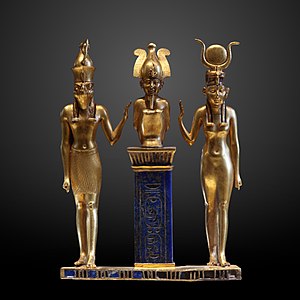
Back أسطورة إيزيس وأوزوريس Arabic اسطورة ايزيس واوزوريس ARZ Mitu d'Osiris AST ওসাইরিসের অতিকথা Bengali/Bangla Mite d'Osiris Catalan Mýtus o Usirovi Czech Osirismythos German Μύθος του Όσιρι Greek Mito de Osiris Spanish Mythe d'Osiris French

The Osiris myth is the most elaborate and influential story in ancient Egyptian mythology. It concerns the murder of the god Osiris, a primeval king of Egypt, and its consequences. Osiris's murderer, his brother Set, usurps his throne. Meanwhile, Osiris's wife Isis restores her husband's body, allowing him to posthumously conceive their son, Horus. The remainder of the story focuses on Horus, the product of the union of Isis and Osiris, who is at first a vulnerable child protected by his mother and then becomes Set's rival for the throne. Their often violent conflict ends with Horus's triumph, which restores maat (cosmic and social order) to Egypt after Set's unrighteous reign and completes the process of Osiris's resurrection.
The myth, with its complex symbolism, is integral to ancient Egyptian conceptions of kingship and succession, conflict between order and disorder, and especially death and the afterlife. It also expresses the essential character of each of the four deities at its center, and many elements of their worship in ancient Egyptian religion were derived from the myth.
The Osiris myth reached its basic form in or before the 24th century BCE. Many of its elements originated in religious ideas, but the struggle between Horus and Set may have been partly inspired by a regional conflict in Predynastic or Early Dynastic times. Scholars have tried to discern the exact nature of the events that gave rise to the story, but they have reached no definitive conclusions.
Parts of the myth appear in a wide variety of Egyptian texts, from funerary texts and magical spells to short stories. The story is, therefore, more detailed and more cohesive than any other ancient Egyptian myth. Yet no Egyptian source gives a full account of the myth, and the sources vary widely in their versions of events. Greek and Roman writings, particularly On Isis and Osiris by Plutarch, provide more information but may not always accurately reflect Egyptian beliefs. Through these writings, the Osiris myth persisted after knowledge of most ancient Egyptian beliefs was lost, and it is still well known today.